Social learning spreads knowledge about dangerous humans among American crows
- PMID: 21715408
- PMCID: PMC3234554
- DOI: 10.1098/rspb.2011.0957
Social learning spreads knowledge about dangerous humans among American crows
Abstract
Individuals face evolutionary trade-offs between the acquisition of costly but accurate information gained firsthand and the use of inexpensive but possibly less reliable social information. American crows (Corvus brachyrhynchos) use both sources of information to learn the facial features of a dangerous person. We exposed wild crows to a novel 'dangerous face' by wearing a unique mask as we trapped, banded and released 7-15 birds at five study sites near Seattle, WA, USA. An immediate scolding response to the dangerous mask after trapping by previously captured crows demonstrates individual learning, while an immediate response by crows that were not captured probably represents conditioning to the trapping scene by the mob of birds that assembled during the capture. Later recognition of dangerous masks by lone crows that were never captured is consistent with horizontal social learning. Independent scolding by young crows, whose parents had conditioned them to scold the dangerous mask, demonstrates vertical social learning. Crows that directly experienced trapping later discriminated among dangerous and neutral masks more precisely than did crows that learned through social means. Learning enabled scolding to double in frequency and spread at least 1.2 km from the place of origin over a 5 year period at one site.
Figures



Similar articles
-
Rapid Learning and Long-Term Memory for Dangerous Humans in Ravens (Corvus corax).Front Psychol. 2020 Oct 21;11:581794. doi: 10.3389/fpsyg.2020.581794. eCollection 2020. Front Psychol. 2020. PMID: 33192900 Free PMC article.
-
Categorical learning between 'male' and 'female' photographic human faces in jungle crows (Corvus macrorhynchos).Behav Processes. 2011 Jan;86(1):109-18. doi: 10.1016/j.beproc.2010.10.002. Epub 2010 Oct 31. Behav Processes. 2011. PMID: 20971169
-
Distinct neural circuits underlie assessment of a diversity of natural dangers by American crows.Proc Biol Sci. 2013 Jul 3;280(1765):20131046. doi: 10.1098/rspb.2013.1046. Print 2013 Aug 22. Proc Biol Sci. 2013. PMID: 23825209 Free PMC article.
-
Individual and social factors affecting the ability of American crows to solve and master a string pulling task.Ethology. 2020 Feb;126(2):229-245. doi: 10.1111/eth.12980. Epub 2019 Dec 30. Ethology. 2020. PMID: 33776175 Free PMC article.
-
The evolutionary origins and ecological context of tool use in New Caledonian crows.Behav Processes. 2012 Feb;89(2):153-65. doi: 10.1016/j.beproc.2011.11.005. Epub 2011 Dec 28. Behav Processes. 2012. PMID: 22209954 Review.
Cited by
-
Predator metamorphosis and its consequence for prey risk assessment.Behav Ecol. 2024 Mar 6;35(3):arae014. doi: 10.1093/beheco/arae014. eCollection 2024 May-Jun. Behav Ecol. 2024. PMID: 38545452 Free PMC article.
-
Socio-cultural brain reprogramming-The uniqueness of human cognition.Front Hum Neurosci. 2024 Mar 12;18:1331213. doi: 10.3389/fnhum.2024.1331213. eCollection 2024. Front Hum Neurosci. 2024. PMID: 38532787 Free PMC article. No abstract available.
-
Wild mockingbirds distinguish among familiar humans.Sci Rep. 2023 Jun 24;13(1):10259. doi: 10.1038/s41598-023-36225-x. Sci Rep. 2023. PMID: 37355713 Free PMC article.
-
Connecting animal and human cognition to conservation.Curr Opin Behav Sci. 2017 Aug;16:87-92. doi: 10.1016/j.cobeha.2017.04.005. Epub 2017 May 16. Curr Opin Behav Sci. 2017. PMID: 36743258 Free PMC article.
-
Social dynamics impact scolding behaviour in captive groups of common ravens (Corvus corax).Front Zool. 2022 Dec 12;19(1):32. doi: 10.1186/s12983-022-00477-6. Front Zool. 2022. PMID: 36503565 Free PMC article.
References
-
- Grant P. R., Grant B. R. 2007. How and why species multiply: the radiation of Darwin's finches. Princeton, NJ: Princeton University
-
- Johnston T. D., Pietrewicz A. T. (eds) 1985. Issues in the ecological study of learning. Hillsdale, NJ: L. Erlbaum Associates
-
- Staddon J. E. R. 1983. Adaptive behavior and learning. Cambridge, UK: Cambridge University Press
-
- Marzluff J. M. 1988. Do pinyon jays use prior experience in their choice of a nest site? Anim. Behav. 36, 1–1010.1016/S0003-3472(88)80244-6 (doi:10.1016/S0003-3472(88)80244-6) - DOI - DOI
-
- Feldman M. W., Aoki K., Kumm J. 1996. Individual versus social learning: evolutionary analysis in a fluctuating environment. Anthropol. Sci. 104, 209–231
Publication types
MeSH terms
LinkOut - more resources
Full Text Sources


